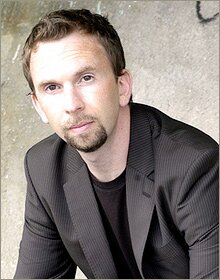Three Questions for Andy Budd
Published 2 years ago, mid-May under Design, SXSW, Standards, Three Questions For my third interview in my Three Questions interview series, I had the pleasure to interview Andy Budd of Clearleft. Andy is the creative director at Clearleft and a well known UX designer and web standards expert.
For my third interview in my Three Questions interview series, I had the pleasure to interview Andy Budd of Clearleft. Andy is the creative director at Clearleft and a well known UX designer and web standards expert.
Andy is the founder and organizer of the amazing d.Construct conference (check out last year’s d.Construct podcasts), he’s the author of CSS Mastery: Advanced Web Standard Solutions, and he publishes a well-read blog at andybudd.com.
Mr. Budd is also a popular speaker at web conferences. Alongside his Clearleft cohort Jeremy Keith he gave an excellent talk entitled “How to Bluff Your Way in Web 2.0″ at South by Southwest Interactive, and he’ll be speaking at the upcoming An Event Apart: Seattle.
Keep reading for Andy on the role of web conferences, a broader approach to design, and dealing with client communication and buzzwords.
Three Questions for Andy Budd
Rob Goodlatte
Do you think the role or importance of web conferences has changed or is changing? If so, how has that change affected how you organize a conference like d.Construct?
Andy Budd
I don’t think the role of web conferences are changing, but I think your relationship with them changes over time. When I first started going to conferences, it was to see my design heroes like Jeffrey Zeldman or Jeff Veen, and to learn new techniques. However the more conferences I attend, the more focus I have on networking and hallway conversations. The event becomes much less about education and much more on inspiration, and the best ones are celebrations of the trade. Whenever I get back from events like SXSW, XTech or d.Construct, I’m re-invigerated and my head is spinning with great ideas.
With d.Construct we try to get a nice balance between all these factors. We have educational speakers like Cameron Moll, Peter Merholz and Leisa Reichelt, doing practical sessions with real take-home value. We also have inspirational speakers like Tom Coates, Jared Spool and Matt Webb to enthuse the audience. We’ve got long breaks so everybody can chat, and some great parties line up from the BBC and Yahoo! On top of that, we’ve got two days of workshops beforehand, and are helping to organise a BarCamp afterwards. So d.Construct should have something for everybody this year.
Rob
I often find myself playing with a design until it just looks right. Other designers I’ve talked to, such as Jeff Croft, structure designs around the golden ratio and rules of thumb. Would you say you approach design from a more rational perspective or an emotional / impulsive perspective?
Andy
I’d like to take a step back and discuss the meaning of design. Most people see design as the “prettying up” of interfaces, but it’s much deeper and more strategic than that. I don’t see design as an artistic pursuit, although it obviously has artistic attributes. Design is about solving problems in a visual medium, and starts well before mouse touches canvas.
At Clearleft we try to design the whole user experience, so spend a lot of time talking to clients, users and other stakeholders. By doing this we can uncover their goals, and design a system that meets everybody’s needs. So by the time we reach the visual design stage, a good deal of design work has already been done. We know the site structure, the navigation, what elements are required on each page, and their relative importance. Now this doesn’t mean that the role of the visual design is redundant. Far from it. This is why we ensure our designers are involved in the whole process and not just the visual design stage.
The role of visual design is twofold. On the emotional side, the colours, layout, typography and imagery need to convey the right message or experience to the audience. On the more rational side, the design needs to expose the correct hierarchy, and move users in the desired direction without impediment. As such, a great designer is somebody who understand both these tensions and can produce the optimal balance between the two. Something that’s both highly effective and looks great.
Rob
Do you feel that buzzwords like “Web 2.0� are healthy for the web or do they do more harm than good?
Andy
We use the term web 2.0 around the office, because it’s a common reference point and we all understand what we’re referring to. However we try to avoid using the term with clients because the point of reference isn’t always the same. Imagine a situation where a client is trying to communicate one concept, but the developer is understanding something else. As such, we try to be as explicit as possible. Is it the social aspect you’re talking about, the openness of data, the richer user experience, or simply the design aesthetic?
I don’t think the term itself is harmful. It’s the potential for misunderstanding and miscommunication that causes the problems.
Thanks for the great interview Andy. I highly recommend checking out his blog at andybudd.com for more great insight. If you’re looking for more interview goodness, check out my interviews with Bryan Veloso and Jeff Croft.

Great interview series Rob! I look forward to reading the next one.
[...] I asked Mark Boulton, Andy Budd, and Jeff Croft, three designers I deeply respect, about designing on impulse versus intention. They each had something different to say, but they each presented a design process far more rationalized and justified than my own. Andy said something particularly interesting — I think it’s the kernal I’ve been looking for: [...]